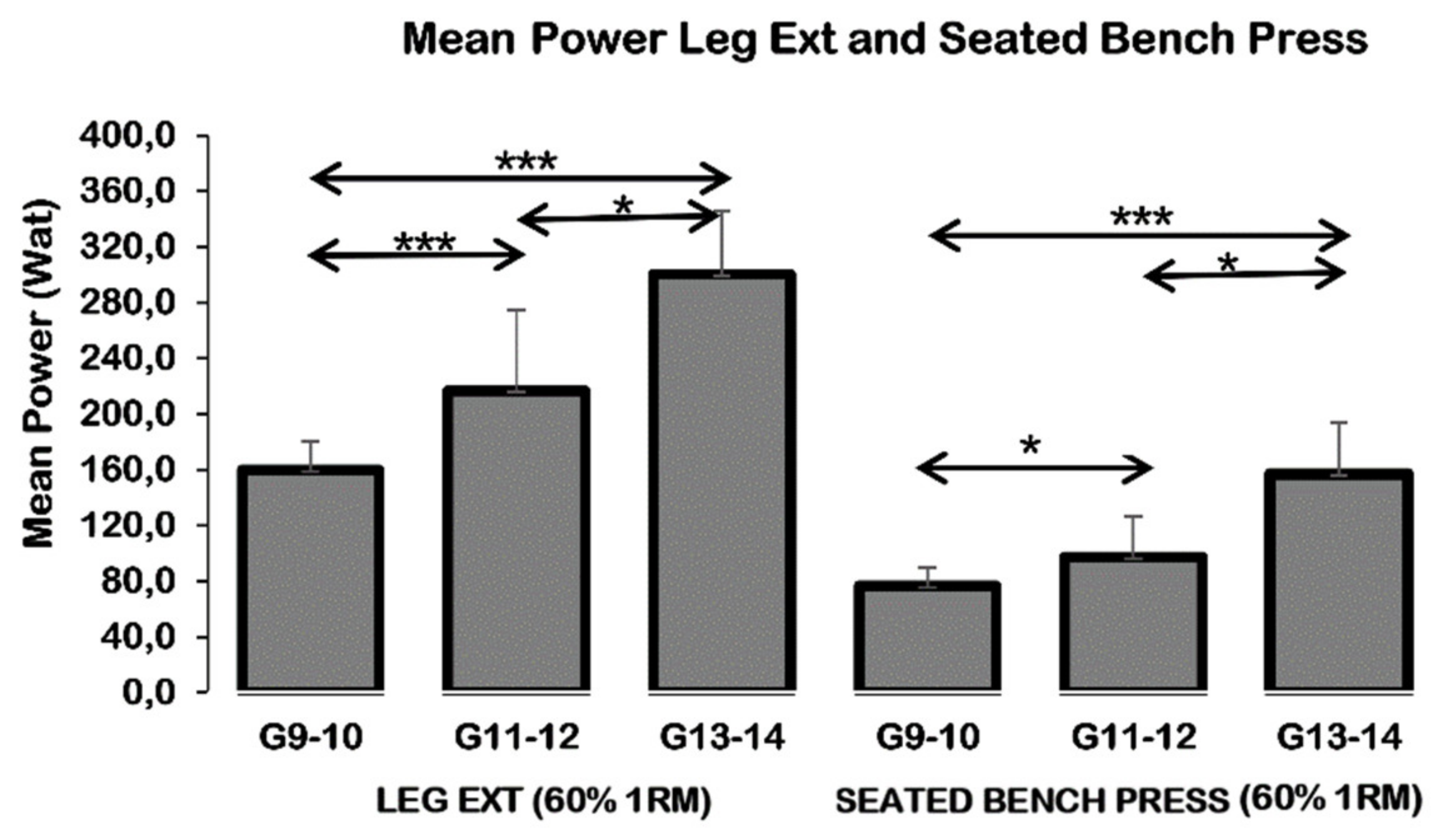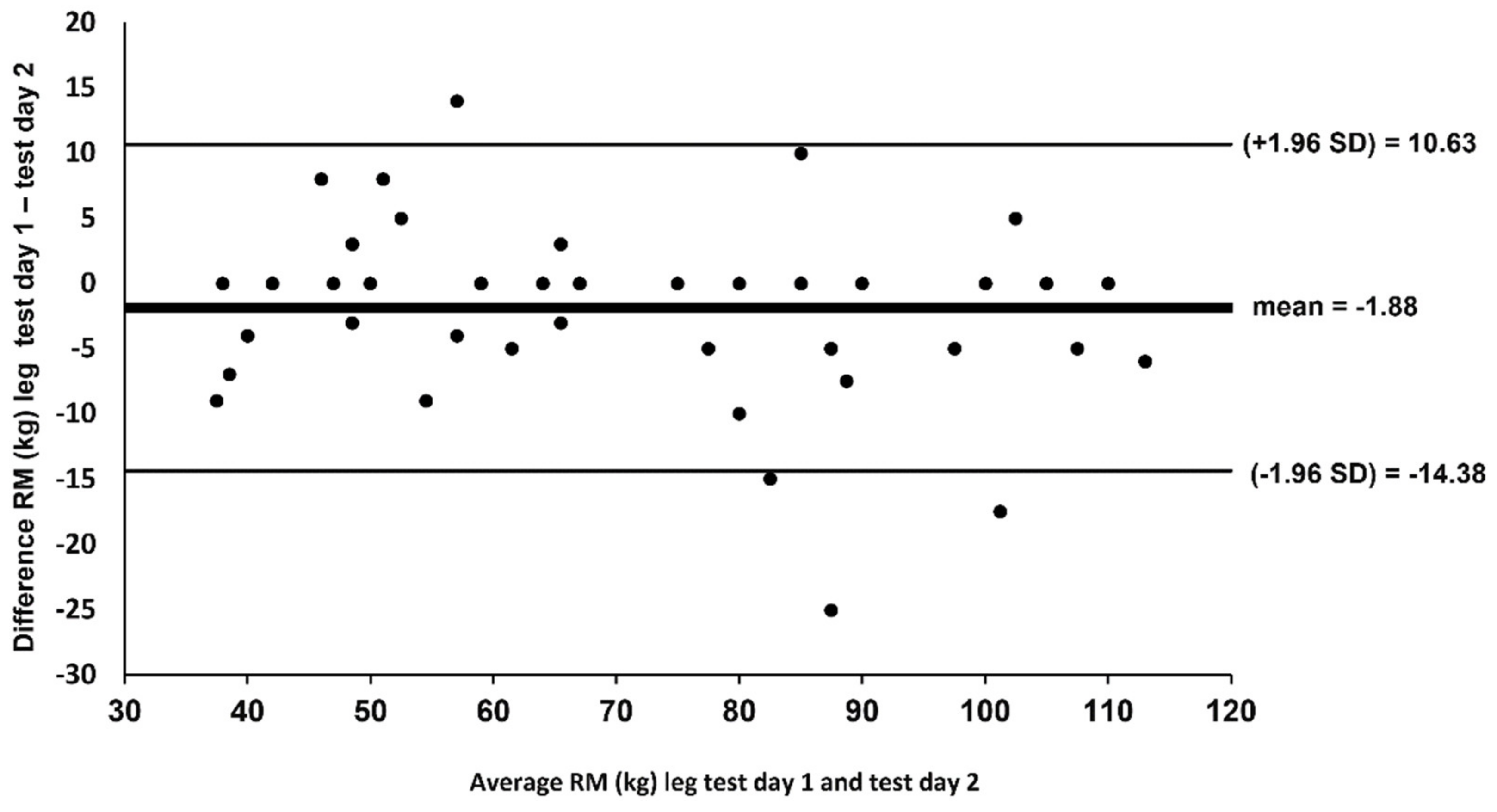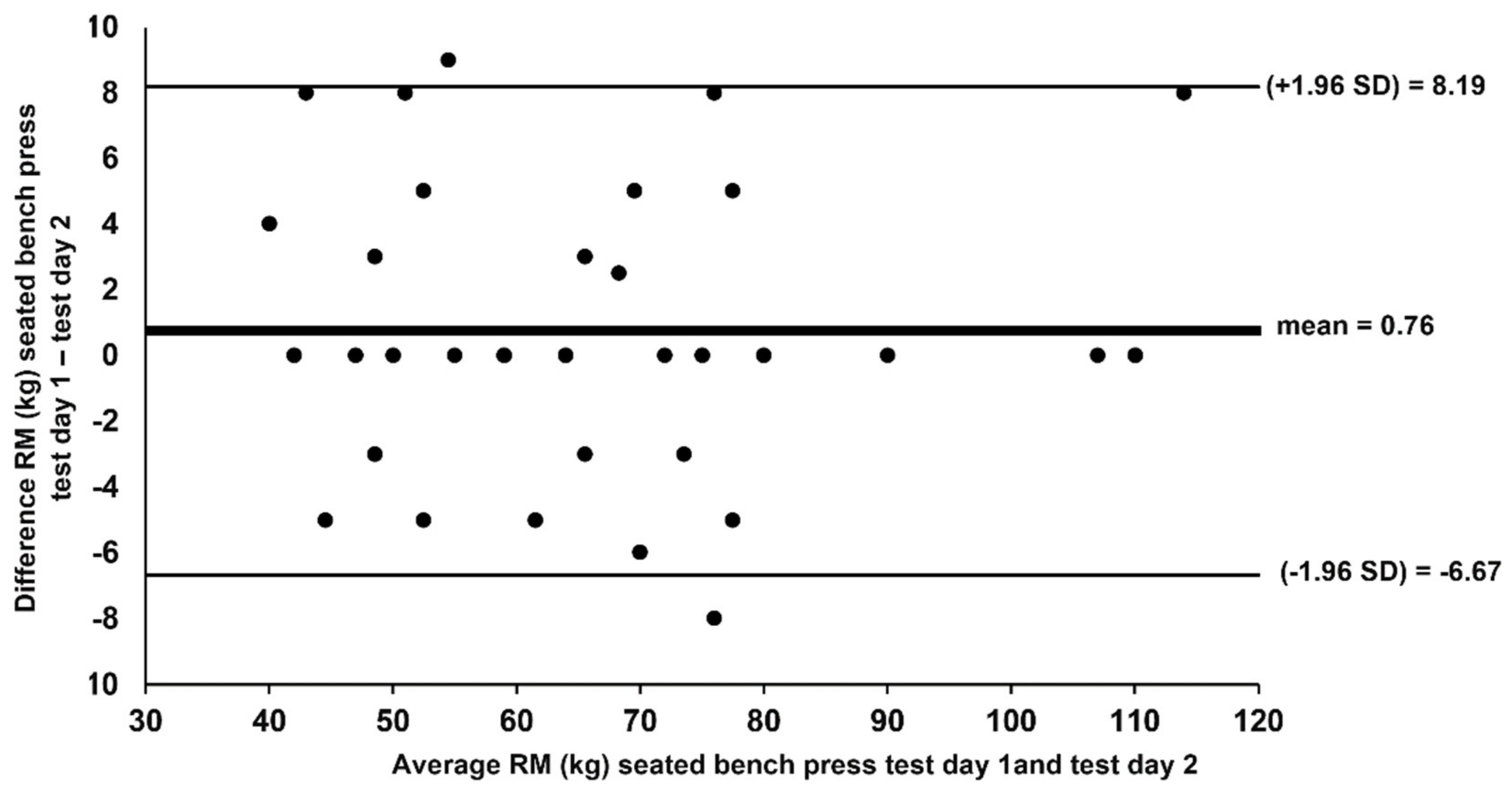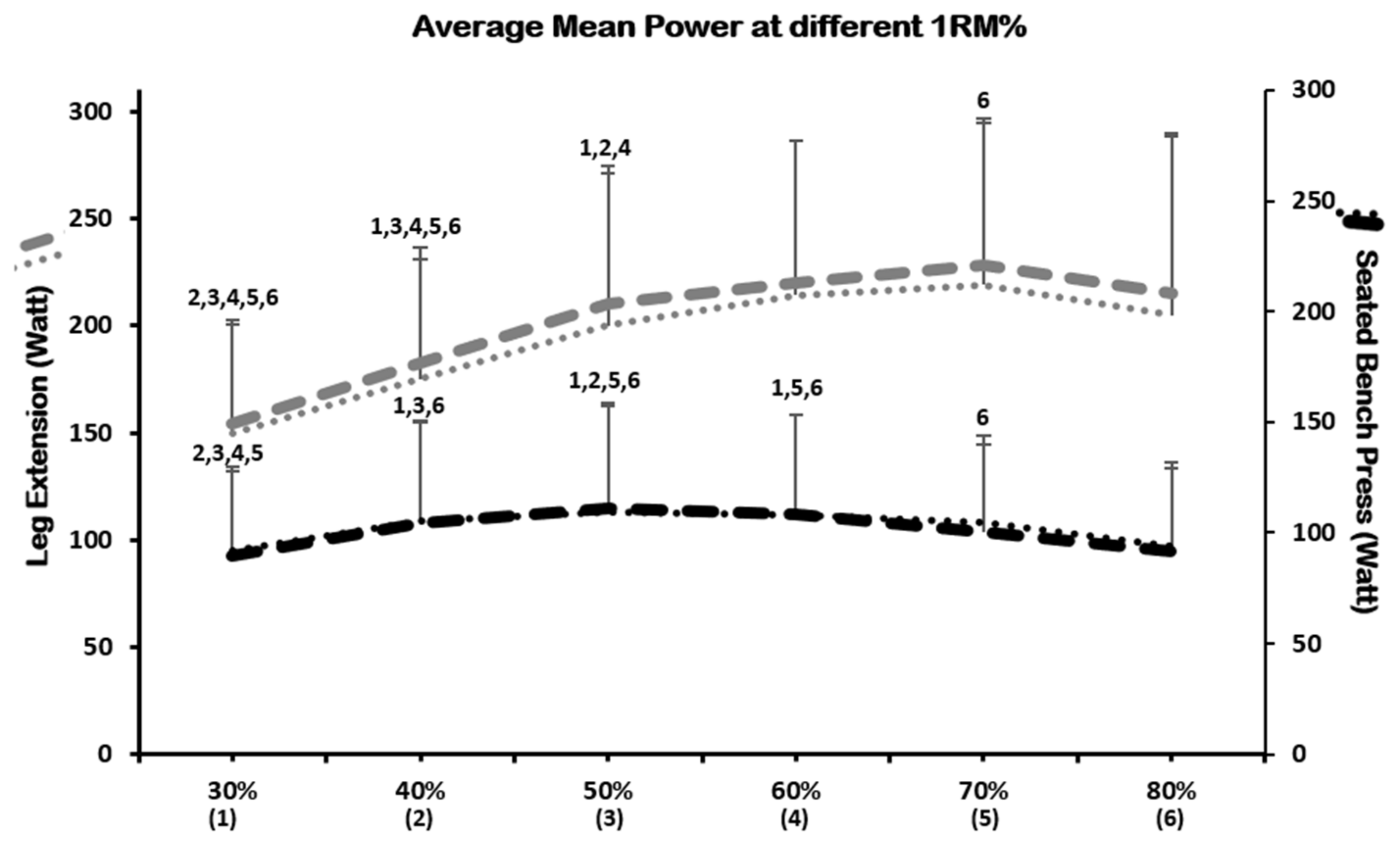Test-Retest and Minimal Detectable Change in the Assessment of Muscle Strength and Muscle Power in Upper and Lower Extremity Exercises in 9- to 14-Year-Old Children
Abstract
1. Introduction
2. Materials and Methods
2.1. Study Design and Participants
2.1.1. Design
2.1.2. Ethical Approval
2.1.3. Participants
2.2. Measurements and Methods
2.2.1. One-Repetition Maximum Testing
2.2.2. Muscle Power Testing
2.3. Statistical Analysis
3. Results
4. Discussion
5. Conclusions
Supplementary Materials
Author Contributions
Funding
Institutional Review Board Statement
Informed Consent Statement
Data Availability Statement
Conflicts of Interest
References
- García-Hermoso, A.; Ramírez-Campillo, R.; Izquierdo, M. Is Muscular Fitness Associated with Future Health Benefits in Children and Adolescents? A Systematic Review and Meta-Analysis of Longitudinal Studies. Sport. Med. 2019, 49, 1079–1094. [Google Scholar] [CrossRef] [PubMed]
- Artero, E.G.; Ruiz, J.R.; Ortega, F.B.; España-Romero, V.; Vicente-Rodríguez, G.; Molnar, D.; Gottrand, F.; González-Gross, M.; Breidenassel, C.; Moreno, L.A.; et al. Muscular and cardiorespiratory fitness are independently associated with metabolic risk in adolescents: The HELENA study. Pediatr. Diabetes 2011, 12, 704–712. [Google Scholar] [CrossRef] [PubMed]
- Cohen, D.D.; Gómez-Arbeláez, D.; Camacho, P.A.; Pinzon, S.; Hormiga, C.; Trejos-Suarez, J.; Duperly, J.; Lopez-Jaramillo, P. Low muscle strength is associated with metabolic risk factors in Colombian children: The ACFIES study. PLoS ONE 2014, 9, e93150. [Google Scholar] [CrossRef] [PubMed]
- Shaffer, T.E.; Coryllos, E.; Dyment, P.G. Weight training and weight lifting: Information for the pediatrician. Phys. Sportsmed. 1983, 11, 157–161. [Google Scholar] [CrossRef]
- Holloway, J.B.; Beuter, A.; Duda, J.L. Self-Efficacy and Training for Strength in Adolescent Girls. J. Appl. Soc. Psychol. 1988, 18, 699–719. [Google Scholar] [CrossRef]
- Morris, F.L.; Naughton, G.A.; Gibbs, J.L.; Carlson, J.S.; Wark, J.D. Prospective ten-month exercise intervention in premenarcheal girls: Positive effects on bone and lean mass. J. Bone Miner. Res. 1997, 12, 1453–1462. [Google Scholar] [CrossRef]
- Micheli, L.J.; Glassman, R.; Klein, M. The prevention of sports injuries in children. Clin. Sports Med. 2000, 19, 821–834. [Google Scholar] [CrossRef]
- Lillegard, W.A.; Brown, E.W.; Wilson, D.J.; Henderson, R.; Lewis, E. Efficacy of strength training in prepubescent to early postpubescent males and females: Effects of gender and maturity. Dev. Neurorehabil. 1997, 1, 147–157. [Google Scholar] [CrossRef]
- Stricker, P.R.; Faigenbaum, A.D.; McCambridge, T.M. Resistance Training for Children and Adolescents. Pediatrics 2020, 145, e20201011. [Google Scholar] [CrossRef] [PubMed]
- Ortega, F.B.; Cadenas-Sánchez, C.; Sánchez-Delgado, G.; Mora-González, J.; Martínez-Téllez, B.; Artero, E.G.; Castro-Piñero, J.; Labayen, I.; Chillón, P.; Löf, M.; et al. Systematic Review and Proposal of a Field-Based Physical Fitness-Test Battery in Preschool Children: The PREFIT Battery. Sport. Med. 2015, 45, 533–555. [Google Scholar] [CrossRef] [PubMed]
- Williams, T.D.; Tolusso, D.V.; Fedewa, M.V.; Esco, M.R. Comparison of Periodized and Non-Periodized Resistance Training on Maximal Strength: A Meta-Analysis. Sport. Med. 2017, 47, 2083–2100. [Google Scholar] [CrossRef] [PubMed]
- Washington, R.L.; Bernhardt, D.T.; Gomez, J.; Johnson, M.D.; Martin, T.J.; Rowland, T.W.; Small, E.; LeBlanc, C.; Malina, R.; Krein, C.; et al. Strength training by children and adolescents. Pediatrics 2001, 107, 1470–1472. [Google Scholar]
- Castro-Piñero, J.; Ortega, F.B.; Artero, E.G.; Girela-Rejón, M.J.; Mora, J.; Sjöström, M.; Ruiz, J.R. Assessing muscular strength in youth: Usefulness of standing long jump as a general index of muscular fitness. J. Strength Cond. Res. 2010, 24, 1810–1817. [Google Scholar] [CrossRef] [PubMed]
- Faigenbaum, A.D.; McFarland, J.E.; Herman, R.E.; Naclerio, F.; Ratamess, N.A.; Kang, J.; Myer, G.D. Reliability of the one-repetition-maximum power clean test in adolescent athletes. J. Strength Cond. Res. 2012, 26, 432–437. [Google Scholar] [CrossRef] [PubMed]
- Fry, A.C.; Irwin, C.C.; Nicoll, J.X.; Ferebee, D.E. Muscular strength and power in 3- To 7-year-old children. Pediatr. Exerc. Sci. 2015, 27, 345–354. [Google Scholar] [CrossRef]
- Myer, G.D.; Wall, E.J. Resistance Training in the Young Athlete. Oper. Tech. Sports Med. 2006, 14, 218–230. [Google Scholar] [CrossRef]
- Lloyd, R.S.; Faigenbaum, A.D.; Stone, M.H.; Oliver, J.L.; Jeffreys, I.; Moody, J.A.; Brewer, C.; Pierce, K.C.; McCambridge, T.M.; Howard, R.; et al. Position statement on youth resistance training: The 2014 International Consensus. Br. J. Sports Med. 2014, 48, 498–505. [Google Scholar] [CrossRef] [PubMed]
- Faigenbaum, A.D.; Milliken, L.A.; Westcott, W.L. Maximal Strength Testing in Healthy Children. J. Strength Cond. Res. 2003, 17, 162–166. [Google Scholar] [CrossRef]
- Sapega, A.A.; Drillings, G. The definition and assessment of muscular power. J. Orthop. Sports Phys. Ther. 1983, 5, 7–9. [Google Scholar] [CrossRef] [PubMed]
- Winter, E.M.; Abt, G.; Brookes, F.B.C.; Challis, J.H.; Fowler, N.E.; Knudson, D.V.; Knuttgen, H.G.; Kraemer, W.J.; Lane, A.M.; Van Mechelen, W.; et al. Misuse of “Power” and Other Mechanical Terms in Sport and Exercise Science Research. J. Strength Cond. Res. 2016, 30, 292–300. [Google Scholar] [CrossRef] [PubMed]
- Turner, A.N.; Comfort, P.; McMahon, J.; Bishop, C.; Chavda, S.; Read, P.; Mundy, P.; Lake, J. Developing Powerful Athletes, Part 1. Strength Cond. J. 2020, 42, 30–39. [Google Scholar] [CrossRef]
- Faigenbaum, A.D.; Myer, G.D. Resistance training among young athletes: Safety, efficacy and injury prevention effects. Br. J. Sports Med. 2010, 44, 56–63. [Google Scholar] [CrossRef]
- Johnson, B.A.; Salzberg, C.L.; Stevenson, D.A. A systematic review: Plyometric training programs for young children. J. Strength Cond. Res. 2011, 25, 2623–2633. [Google Scholar] [CrossRef] [PubMed]
- Ortega, F.B.; Artero, E.G.; Ruiz, J.R.; España-Romero, V.; Jiménez-Pavón, D.; Vicente-Rodriguez, G.; Moreno, L.A.; Manios, Y.; Béghin, L.; Ottevaere, C.; et al. Physical fitness levels among European adolescents: The HELENA study. Br. J. Sports Med. 2011, 45, 20–29. [Google Scholar] [CrossRef]
- Tomkinson, G.R.; Carver, K.D.; Atkinson, F.; Daniell, N.D.; Lewis, L.K.; Fitzgerald, J.S.; Lang, J.J.; Ortega, F.B. European normative values for physical fitness in children and adolescents aged 9-17 years: Results from 2 779 165 Eurofit performances representing 30 countries. Br. J. Sports Med. 2018, 52, 1445–1456. [Google Scholar] [CrossRef]
- Sumnik, Z.; Matyskova, J.; Hlavka, Z.; Durdilova, L.; Soucek, O.; Zemkova, D. Reference data for jumping mechanography in healthy children and adolescents aged 6-18 years. J. Musculoskelet. Neuronal Interact 2013, 13, 297–311. [Google Scholar] [PubMed]
- Santos, A.N.; Pavão, S.L.; Avila, M.A.; Salvini, T.F.; Rocha, N.A.C.F. Reliability of isokinetic evaluation in passive mode for knee flexors and extensors in healthy children. Braz. J. Phys. Ther. 2013, 17, 112–120. [Google Scholar] [CrossRef] [PubMed]
- Parsons, J.L.; Porter, M.M. Reliability of measuring hip and knee power and movement velocity in active youth. Pediatr. Phys. Ther. 2015, 27, 82–89. [Google Scholar] [CrossRef]
- Meylan, C.M.P.; Cronin, J.B.; Oliver, J.L.; Hughes, M.M.G.; Jidovtseff, B.; Pinder, S. The reliability of isoinertial force–velocity–power profiling and maximal strength assessment in youth. Sports Biomech. 2015, 14, 68–80. [Google Scholar] [CrossRef] [PubMed]
- Hopkins, W.G. Measures of reliability in sports medicine and science. Sport. Med. 2000, 30, 1–15. [Google Scholar] [CrossRef]
- Krabbe, P.F.M. Choice Models. In The Measurement of Health and Health Status; Elsevier: Amsterdam, The Netherlands, 2017; pp. 197–225. [Google Scholar]
- Grgic, J.; Lazinica, B.; Schoenfeld, B.J.; Pedisic, Z. Test–Retest Reliability of the One-Repetition Maximum (1RM) Strength Assessment: A Systematic Review. Sport. Med. Open 2020, 6, 31. [Google Scholar] [CrossRef]
- Tánori-Tapia, J.M.; Romero-Pérez, E.M.; Camberos, N.A.; Horta-Gim, M.A.; Núñez-Othón, G.; Medina-Pérez, C.; de Paz, J.A. Determination of the Minimum Detectable Change in the Total and Segmental Volumes of the Upper Limb, Evaluated by Perimeter Measurements. Healthcare 2020, 8, 285. [Google Scholar] [CrossRef] [PubMed]
- Atkinson, G.; Nevill, A.M. Statistical methods for assessing measurement error (reliability) in variables relevant to sports medicine. Sport. Med. 1998, 26, 217–238. [Google Scholar] [CrossRef]
- Koo, T.K.; Li, M.Y. A Guideline of Selecting and Reporting Intraclass Correlation Coefficients for Reliability Research. J. Chiropr. Med. 2016, 15, 155–163. [Google Scholar] [CrossRef]
- Robertson, R.J.; Goss, F.L.; Andreacci, J.L.; Dubé, J.J.; Rutkowski, J.J.; Frazee, K.M.; Aaron, D.J.; Metz, K.F.; Kowallis, R.A.; Snee, B.M. Validation of the children’s OMNI-resistance exercise scale of perceived exertion. Med. Sci. Sports Exerc. 2005, 37, 819–826. [Google Scholar] [CrossRef] [PubMed]
- Orange, S.T.; Metcalfe, J.W.; Liefeith, A.; Marshall, P.; Madden, L.A.; Fewster, C.R.; Vince, R.V. Validity and Reliability of a Wearable Inertial Sensor to Measure Velocity and Power in the Back Squat and Bench Press. J. Strength Cond. Res. 2018, 33, 2398–2408. [Google Scholar] [CrossRef] [PubMed]
- Rosner, B. Statistical methods in ophthalmology: An adjustment for the intraclass correlation between eyes—PubMed. Biometrics 1982, 38, 105–114. [Google Scholar] [CrossRef]
- Faigenbaum, A.; Westcott, W.; Long, C.; Loud, R.; Delmonico, M.; Micheli, L. Relationship Between Repetitions and Selected Percentages of the One Repetition Maximum in Healthy Children. Pediatr. Phys. Ther. 1998, 10, 110–113. [Google Scholar] [CrossRef]
- Gillen, Z.M.; Miramonti, A.A.; McKay, B.D.; Leutzinger, T.J.; Cramer, J.T. Test-retest reliability and concurrent validity of athletic performance combine tests in 6-15-year-old male athletes. J. Strength Cond. Res. 2018, 32, 2783–2794. [Google Scholar] [CrossRef]
- Ayán-Pérez, C.; Cancela-Carral, J.M.; Lago-Ballesteros, J.; Martínez-Lemos, I. Reliability of Sargent Jump Test in 4- to 5-Year-Old Children. Percept. Mot. Skills 2017, 124, 39–57. [Google Scholar] [CrossRef]
- Radnor, J.M.; Oliver, J.L.; Waugh, C.M.; Myer, G.D.; Lloyd, R.S. The influence of maturity status on muscle architecture in school-aged boys. Pediatr. Exerc. Sci. 2020, 32, 89–96. [Google Scholar] [CrossRef]
- Kraemer, W.J.; Ratamess, N.A.; Hymer, W.C.; Nindl, B.C.; Fragala, M.S. Growth Hormone(s), Testosterone, Insulin-Like Growth Factors, and Cortisol: Roles and Integration for Cellular Development and Growth With Exercise. Front. Endocrinol. 2020, 11. [Google Scholar] [CrossRef] [PubMed]
- Kern, D.S.; Semmler, J.G.; Enoka, R.M. Long-term activity in upper- and lower-limb muscles of humans. J. Appl. Physiol. 2001, 91, 2224–2232. [Google Scholar] [CrossRef]
- Sinam, V.; Daimei, T.; Singh, I.D.; Devi, D. Comparison of the Upper and Lower Limbs-A Phylogenetic Concept. IOSR J. Dent. Med. Sci. 2015, 14, 14–16. [Google Scholar] [CrossRef]
- Ramos, E.; Frontera, W.R.; Llopart, A.; Feliciano, D. Muscle strength and hormonal levels in adolescents: Gender related differences. Int. J. Sports Med. 1998, 19. [Google Scholar] [CrossRef]
- Laurson, K.R.; Saint-Maurice, P.F.; Welk, G.J.; Eisenmann, J.C. Reference curves for field tests of musculoskeletal fitness in U.S. children and adolescents: The 2012 nhanes national youth fitness survey. J. Strength Cond. Res. 2017, 31, 2075–2082. [Google Scholar] [CrossRef]
- Dyball, K.M.; Taylor, N.F.; Dodd, K.J. Retest reliability of measuring hip extensor muscle strength in different testing positions in young people with cerebral palsy. BMC Pediatr. 2011, 11, 42. [Google Scholar] [CrossRef]






| Sex (Female/Male) | Age (Years) | Height (cm) | Weight (kg) | BMI (kg/m2) | |
|---|---|---|---|---|---|
| G9–10 | 8/8 | 9.53 ± 0.51 | 135.41 ± 4.52 | 32.30 ± 5.43 | 17.55 ± 2.51 |
| G11–12 | 8/8 | 11.50 ± 0.52 | 149.63 ± 7.93 a | 41.59 ± 10.40 a | 18.32 ± 2.84 |
| G13–14 | 8/8 | 13.53 ± 0.52 | 157.20 ± 5.48 abc | 48.15 ± 9.39 abc | 19.58 ± 3.78 |
| Group | Test | Mean | SD | t-Test (p) | ICC | 95% CI | CV | SD | SEM | SEM% | MDC | MDC % |
|---|---|---|---|---|---|---|---|---|---|---|---|---|
| G9–10 | Test | 47.47 | 8.80 | 0.465 | 0.894 | (0.736–0.960) | 0.037 | 0.053 | 2.65 | 5.54 | 7.35 | 15.37 |
| Retest | 48.18 | 7.69 | ||||||||||
| G11–12 | Test | 61.75 | 19.28 | 0.872 | 0.951 | (0.865–0.982) | 0.058 | 0.052 | 4.09 | 6.64 | 11.34 | 18.40 |
| Retest | 61.50 | 18.28 | ||||||||||
| G13–14 | Test | 84.13 | 10.82 | 0.044 * | 0.876 | (0.674–0.956) | 0.028 | 0.038 | 3.85 | 4.52 | 10.66 | 12.52 |
| Retest | 86.20 | 11.30 | ||||||||||
| All Girls | Test | 68.94 | 24.44 | 0.031 * | 0.977 | (0.947–0.990) | 0.037 | 0.050 | 3.77 | 5.38 | 10.45 | 14.90 |
| Retest | 71.34 | 25.28 | ||||||||||
| All Boys | Test | 68.00 | 21.02 | 0.326 | 0.958 | (0.902–0.982) | 0.052 | 0.057 | 4.48 | 6.52 | 12.41 | 18.07 |
| Retest | 69.36 | 22.67 | ||||||||||
| All Sample | Test | 68.47 | 22.59 | 0.032 * | 0.954 | (0.920–0.974) | 0.045 | 0.054 | 4.90 | 7.06 | 13.58 | 19.56 |
| Retest | 70.35 | 23.08 |
| Group | Test | Mean | SD | t-Test (p) | ICC | 95% CI | CV | SD | SEM | SEM% | MDC | MDC % |
|---|---|---|---|---|---|---|---|---|---|---|---|---|
| G9–10 | Test | 57.35 | 12.84 | 0.086 | 0.953 | (0.868–0.983) | 0.035 | 0.033 | 2.61 | 4.61 | 7.24 | 12.80 |
| Retest | 55.76 | 11.53 | ||||||||||
| G11–12 | Test | 56.94 | 9.30 | 0.770 | 0.918 | (0.783–0.971) | 0.034 | 0.036 | 2.86 | 5.01 | 7.92 | 13.87 |
| Retest | 57.25 | 10.92 | ||||||||||
| G13–14 | Test | 75.63 | 19.61 | 0.425 | 0.985 | (0.949–0.995) | 0.028 | 0.043 | 2.47 | 3.30 | 6.84 | 9.15 |
| Retest | 73.93 | 21.31 | ||||||||||
| All Girls | Test | 56.13 | 10.41 | 0.489 | 0.929 | (0.845–0.969) | 0.035 | 0.039 | 2.75 | 4.92 | 7.63 | 13.65 |
| Retest | 55.75 | 10.26 | ||||||||||
| All Boys | Test | 69.54 | 18.93 | 0.063 | 0.981 | (0.955–0.992) | 0.029 | 0.034 | 2.68 | 3.89 | 7.43 | 10.79 |
| Retest | 68.13 | 19.96 | ||||||||||
| All Sample | Test | 62.92 | 16.23 | 0.072 | 0.974 | (0.953–0.985) | 0.032 | 0.036 | 2.91 | 4.67 | 8.07 | 12.93 |
| Retest | 61.94 | 19.90 |
| Group | Test | Mean | SD | t-Test (p) | ICC | 95% CI | CV | SD | SEM | SEM% | MDC | MDC % |
|---|---|---|---|---|---|---|---|---|---|---|---|---|
| G9–10 | Test | 148.28 | 20.28 | 0.379 | 0.651 | (0.255–0.858) | 0.065 | 0.041 | 10.94 | 7.19 | 30.32 | 19.94 |
| Retest | 155.88 | 16.28 | ||||||||||
| G11–12 | Test | 219.47 | 55.12 | 0.513 | 0.853 | (0.634–0.946) | 0.069 | 0.075 | 22.80 | 10.52 | 63.20 | 29.17 |
| Retest | 213.90 | 65.22 | ||||||||||
| G13–14 | Test | 282.92 | 28.86 | 0.065 | 0.696 | (0.634–0.946) | 0.057 | 0.024 | 17.56 | 6.05 | 48.67 | 16.76 |
| Retest | 298.01 | 33.86 | ||||||||||
| All Girls | Test | 215.26 | 81.35 | 0.029 * | 0.937 | (0.843–0.974) | 0.075 | 0.052 | 21.86 | 9.85 | 60.6 | 27.29 |
| Retest | 228.83 | 92.85 | ||||||||||
| All Boys | Test | 222.21 | 56.64 | 0.804 | 0.800 | (0.591–0.909) | 0.096 | 0.078 | 26.69 | 11.96 | 74.00 | 33.16 |
| Retest | 224.18 | 62.76 | ||||||||||
| All Sample | Test | 218.74 | 69.43 | 0.120 | 0.892 | (0.814–0.938) | 0.086 | 0.067 | 24.29 | 10.91 | 67.35 | 30.25 |
| Retest | 226.50 | 78.44 |
| Group | Test | Mean | SD | t-Test (p) | ICC | 95% CI | CV | SD | SEM | SEM% | MDC | MDC % |
|---|---|---|---|---|---|---|---|---|---|---|---|---|
| G9–10 | Test | 74.66 | 13.96 | 0.968 | 0.663 | (0.280–0.896) | 0.083 | 0.077 | 8.17 | 10.82 | 22.65 | 30.01 |
| Retest | 76.27 | 14.58 | ||||||||||
| G11–12 | Test | 98.56 | 29.66 | 0.285 | 0.922 | (0.797–0.972) | 0.075 | 0.059 | 8.23 | 8.48 | 22.80 | 23.49 |
| Retest | 95.60 | 30.14 | ||||||||||
| G13–14 | Test | 155.96 | 36.63 | 0.615 | 0.918 | (0.778–0.972) | 0.061 | 0.037 | 10.66 | 6.78 | 29.53 | 18.79 |
| Retest | 158.33 | 39.03 | ||||||||||
| All Girls | Test | 94.79 | 35.94 | 0.661 | 0.890 | (0.764–0.951) | 0.010 | 0.085 | 11.95 | 12.72 | 33.14 | 35.26 |
| Retest | 93.17 | 36.16 | ||||||||||
| All Boys | Test | 122.81 | 40.06 | 0.764 | 0.951 | (0.889–0.978) | 0.075 | 0.052 | 9.81 | 7.96 | 27.19 | 22.06 |
| Retest | 123.75 | 48.60 | ||||||||||
| All Sample | Test | 108.77 | 43.26 | 0.896 | 0.935 | (0.887–0.963) | 0.091 | 0.076 | 11.26 | 10.37 | 31.22 | 28.75 |
| Retest | 108.46 | 45.10 |
Publisher’s Note: MDPI stays neutral with regard to jurisdictional claims in published maps and institutional affiliations. |
© 2021 by the authors. Licensee MDPI, Basel, Switzerland. This article is an open access article distributed under the terms and conditions of the Creative Commons Attribution (CC BY) license (http://creativecommons.org/licenses/by/4.0/).
Share and Cite
Horta-Gim, M.A.; Romero-Pérez, E.M.; Medina-Pérez, C.; Tánori-Tapia, J.M.; Núñez-Othón, G.; Novo, A.; de Paz, J.A. Test-Retest and Minimal Detectable Change in the Assessment of Muscle Strength and Muscle Power in Upper and Lower Extremity Exercises in 9- to 14-Year-Old Children. Appl. Sci. 2021, 11, 2204. https://doi.org/10.3390/app11052204
Horta-Gim MA, Romero-Pérez EM, Medina-Pérez C, Tánori-Tapia JM, Núñez-Othón G, Novo A, de Paz JA. Test-Retest and Minimal Detectable Change in the Assessment of Muscle Strength and Muscle Power in Upper and Lower Extremity Exercises in 9- to 14-Year-Old Children. Applied Sciences. 2021; 11(5):2204. https://doi.org/10.3390/app11052204
Chicago/Turabian StyleHorta-Gim, Mario A., Ena Monserrat Romero-Pérez, Carlos Medina-Pérez, José Manuel Tánori-Tapia, Gabriel Núñez-Othón, André Novo, and José Antonio de Paz. 2021. "Test-Retest and Minimal Detectable Change in the Assessment of Muscle Strength and Muscle Power in Upper and Lower Extremity Exercises in 9- to 14-Year-Old Children" Applied Sciences 11, no. 5: 2204. https://doi.org/10.3390/app11052204
APA StyleHorta-Gim, M. A., Romero-Pérez, E. M., Medina-Pérez, C., Tánori-Tapia, J. M., Núñez-Othón, G., Novo, A., & de Paz, J. A. (2021). Test-Retest and Minimal Detectable Change in the Assessment of Muscle Strength and Muscle Power in Upper and Lower Extremity Exercises in 9- to 14-Year-Old Children. Applied Sciences, 11(5), 2204. https://doi.org/10.3390/app11052204









